Abalone - a minute to learn, a lifetime to master
One of the many books I devoured as a kid was Erwin Glonnegger's Das Spiele-Buch: Brett- und Legespiele aus aller Welt. Herkunft, Regeln und Geschichte (The Book of Games: Board and tile-based Games from all over the world. Origin, Rules and History).
Rich in graphics and photos, it explained board games old and new, traditional and modern; how earlier versions of backgammon were played in old Egypt and are still being played in Africa simply by digging small holes in the sand and using plant seeds as pieces; the different kinds of peg solitaire; Chess and Xiangqi; Go; Snakes & Ladders; Monopoly and many, many more.
One that drew my attention each time I leafed through the pages was "Abalone". It stood out and piqued my curiosity. The mechanics seemed unique: instead of beating your opponent's pieces by occupying the same field, you had to push his marbles off the board in a sort of Sumo wrestling of the minds.
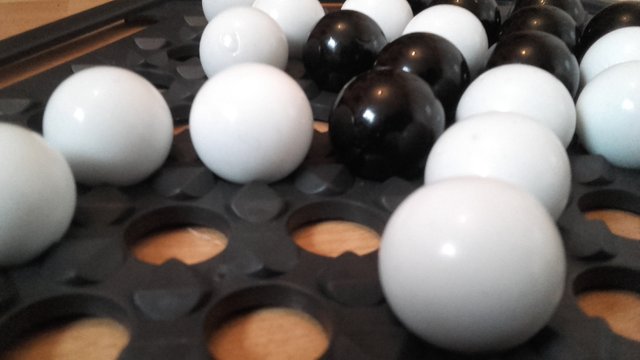
Many years later, I stumbled over the game at a garage sale. I paid 2€ for it... and lacked an opponent, so it collected dust. Every now and then, I could convince a friend to try a round or two, but the games were slow and unexiting and unsatisfying. We overthought each move only to find out that the next move undid all the carefully laid-out plans, as a single move could shift the whole threat scenario. The "game physics" really were something else.
Another few years later, I worked at a kiosk, and more by accident than anything else (I had tried to introduce the game again while visting friends, so I had it in my rucksack), a customer agreed to try it. So we played a few quick and dirty rounds.
I kept it at the shop and we played regularly, getting better and better, our games becoming more thrilling and surprising to each of us every time we played. Five, even ten rounds in one evening became the norm. Bystanders young and old watched, captivated by the beauty of it, figured out the rules quite quickly and soon were also invited to play. So it came to pass that I had to order almost a dozen games via ebay - for their kids, their nieces and nephews and their grandchildren. But mostly for themselves, because they wanted to train at home...
...the attraction is easily explained. Firstly, the game looks simply gorgeous, with its hexagonal field and 14 black and 14 white glass marbles. The mechanics are awesome, you get to literally push your opponent around. The haptic feedback you get and the heavy sound of sheer definitiveness it makes when you move five marbles at once. But what I like most about it:
1. the rules are breathtakingly simple.
In essence, you must know how to count to three. And yes, that is how I always start explaining it. This is how I go on:
I put one white marble in the middle and say: You can move it one step in any direction (I move it one step in all six directions).
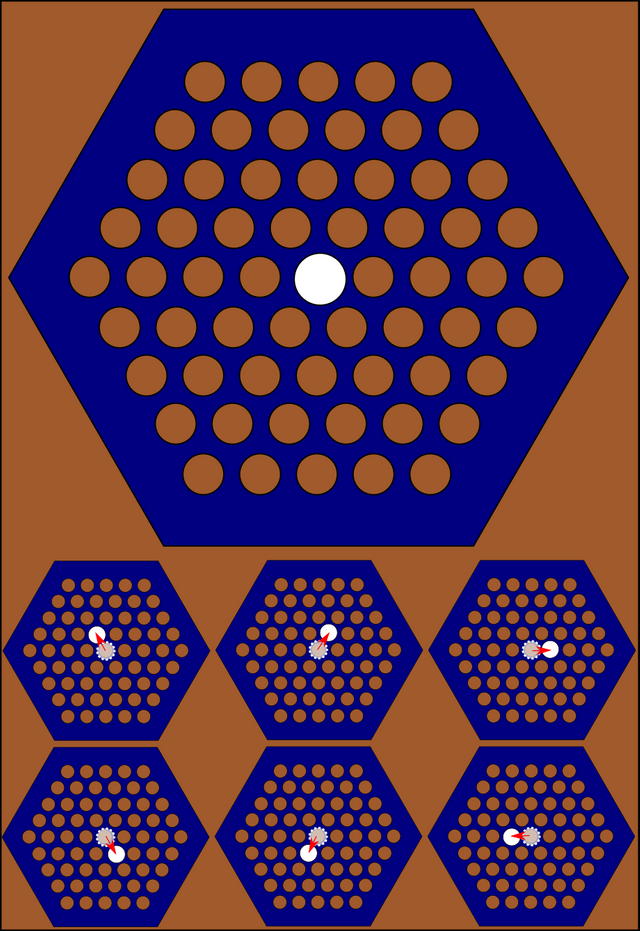
I put a second white marble right next to it. If they are in a row, you can move them one step in any direction - back and forth (in line), and broadside (in parallel)!
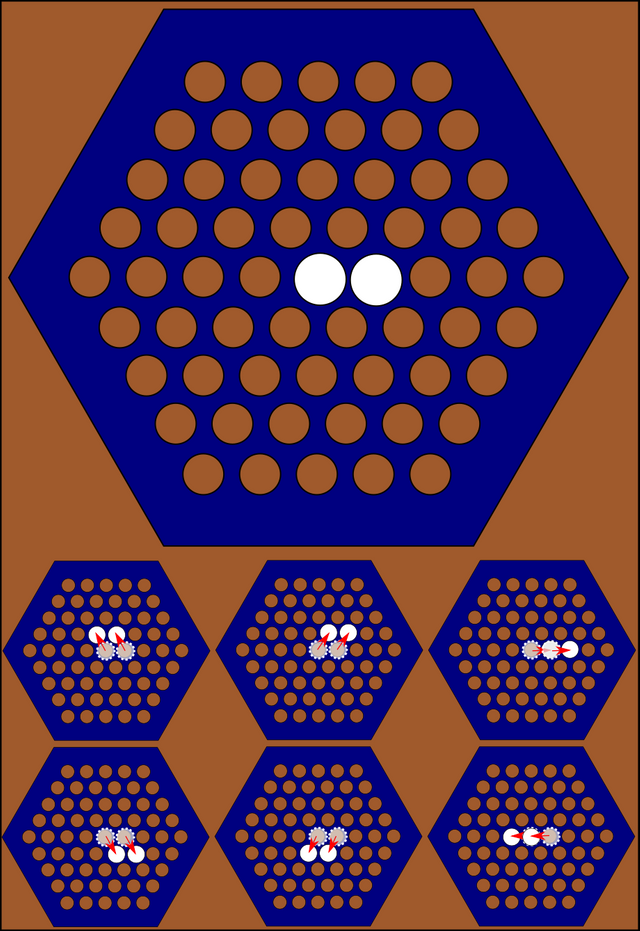
Then I put a third white marble right next to it. If they are in a row, you can move them one step in any direction - back and forth, and broadside!
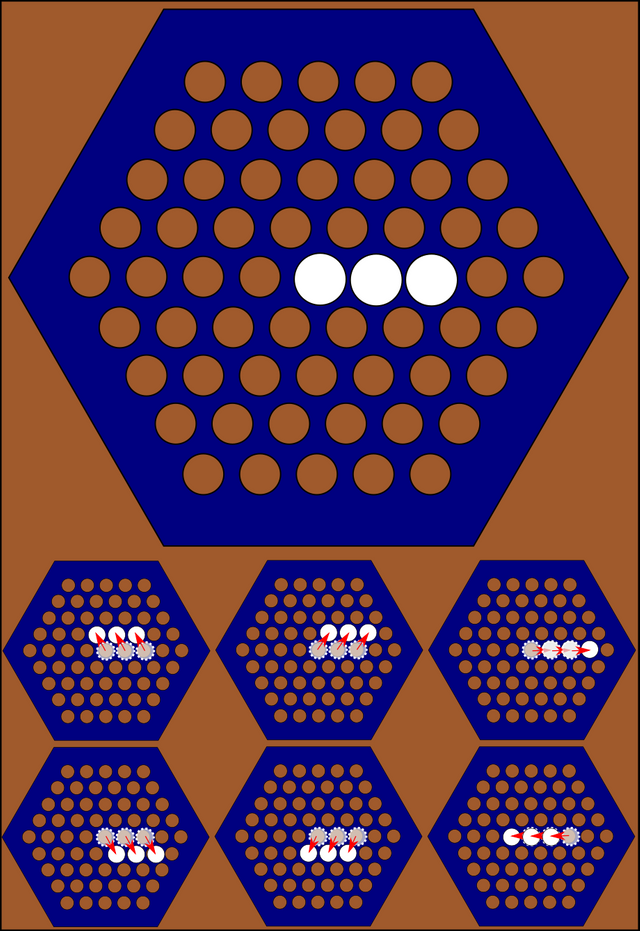
At this point, I stress again you can only move up to three of your own marbles at once, and they have to be in line.
Then I put a fourth marble, this time a black one, next to them to elongate the row. If you have at least one marble more than your opponent has in that row and the field behind that is empty, you can "push" it. So you can move that one single marble with three OR two marbles of your own.
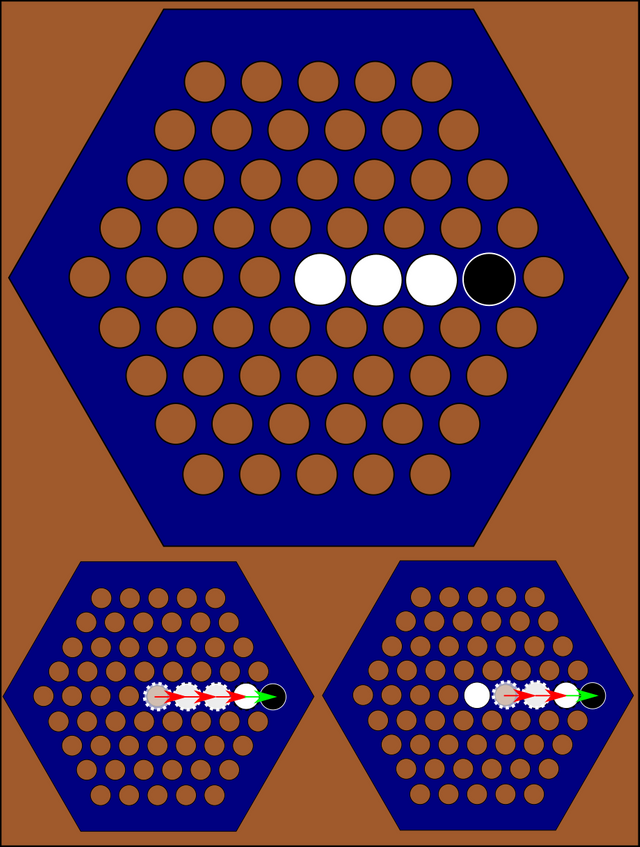
Then I put a fifth marble, again a black one, next to them to elongate the row. That means you can push the opponent's two black marbles with your three white marbles. You can't push them with only two marbles, though, and when I demonstrate this, I just wiggle them a bit, pretending they are "blocked" or "stuck" or "too weak".
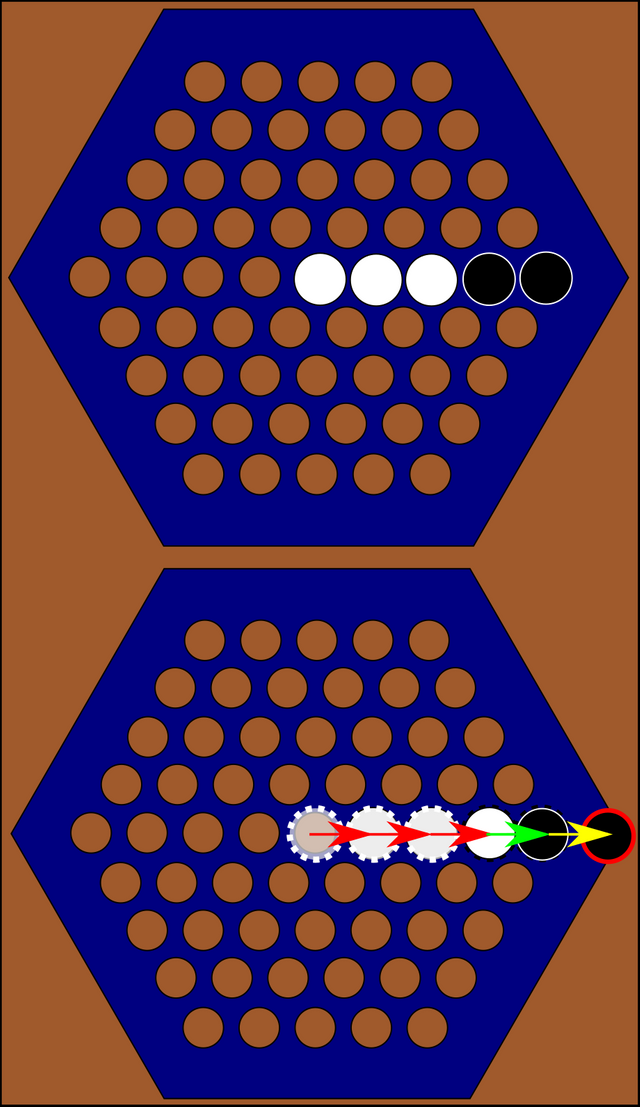
Then I put a sixth marble, again a black one, next to them to elongate the row, to demonstrate how this third marble blocks the push and secures the row.
I remove the last marble again and replace it with a white one to demonstrate that your own marble blocks the push as well.
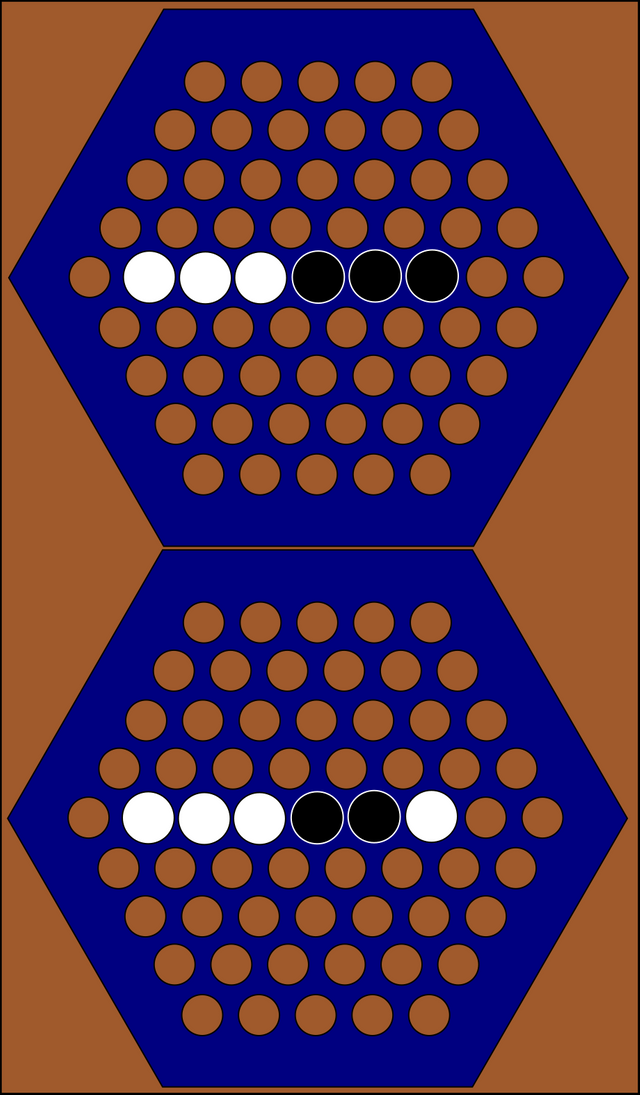
These are the rules. Your aim is to push six of your opponent's marbles off the board, then you win the round.
I set up the starting position, with white on my side, and say "black starts the game."
Annoying 8-year olds suddenly calm down and concentrate. Weary 80-year olds suddenly get excited.
It is a joy to behold.
2. the game is breathtakingly complex.
Although I got fairly good at it quite quickly (at least I think so, I honestly have no comparison except the people I taught the game), playing it at least a dozen times every day against the most diverse opponents, I never got haughty. I could lead five marbles to none and still lose a game, because prematurely pushing those five marbles out brought my armies so close to the edge and wrecked my whole geometry that my opponent, now easily occupying the middle, merely had to push them out one by one, and there was nothing I could do to block or evade or counter.
Clearly, what you want to do is keep your armies together in a compact pattern, and keep them in the middle.
That sounds easier than it is, if you find a worthy opponent to play with every day, because the middle does not have enough space for all 28 marbles. Each attack costs you "energy" and leaves you vulnerable to a counter-attack. If your opponent pushes right through your center of gravity, you are already fighting a losing battle, because you can't fall into his flank if your own marbles block your move on the adjacent side. Even if you manage to separate one of his marbles from the rest of his armies, it will be a constant nuisance you have to work around, and it is more likely that he manages to bring it back into the herd than your being able to form a secure swath in your own ranks to "channel" it to the edge. The best you can do with such a stray marble is to use it as "support" to lean your attack into.
You'll soon find that patterns do emerge, against all likelihood, and begin to develop, fine-tune and discard standard responses.
After a few weeks of playing, a whole realm of strategic possibilities opens up. And when you start dreaming your matches or mentally pushing two black cars against a white one, you know you suffer from Tetris Syndrome.
there are many variations.
For example, the starting position in the original rule book has been abandoned by pro players to make the "race for the middle" more exciting (and to prevent stalemate situations, where one player can defend indefinitely), you'll find the "Dutch Daisy" or "Belgian Daisy" or even more exotic ones like "Snake" or the "Crossed Hearts".
Another variation puts a marble of a third color in the middle, which is immovable ("The Pillar").
In another variation, that marble can be moved also, and the player to push it out first wins the game.
The one we tried a few times - I simply bought two sets of similarly-sized marbles in blue and green instead of buying a new game for almost 50€ - was the three-player variation, everyone against everyone, which also makes for an interesting, almost spiralling, dynamic.
There is a four-player variation (which we haven't tried yet), where you play in teams and can use your ally's marbles to support your "push" against your opponents' marbles.
There is a six-player variation, and I hope to try it one day :)

A common sight at the kiosk: me playing Abalone with my customers, Winter 2015.
Credit: Spock der Kranich (& thanks to N. & M. for allowing me to publish the backs of their heads)
challenge
If you know the game, let me know - I'll bring mine to Amsterdam! I am looking forward to meeting you in battle at the #steemfest :)
trivia
Abalone was invented by Michel Lalet and Laurent Lévi in 1987 and was published in 1988-90. It won the Concours International de Créateurs de Jeux de Société 1988, was nominated for the Spiel des Jahres (Game of the Year) Award 1989, was among the Mensa Select Mind Games 1990 and received the Super As d'Or ("Game of the Decade") in 1998.
There are many different versions by now. I prefer the original, large, self-published one, with its beautiful late-80ies style box design, of course. There is now a considerably much smaller one, which is quite convenient for travel, and even an "Abalone Travel" with tiny, tiny plastic marbles, but with the convenience that closing the lid keeps them in place and "freezes" the game. Also, many different publishers have slapped their logos and package designs on the various versions over time - Asmodee, Parker, Hasbro, Schmidt and probably a few more, depending on the country.
The current Abalone world champion at the Mind Sports Olympiad is Vincent Frochot (France).
links

Sure, let's have a game at Steemfest !
Great :)
When are you gonna be there? I'll be there since 8th, will be up for it anytime :D
10th myself. can't wait!
I'm sure we'll be able to arrange something!
Have not seen you for a while :-)
Very cool - I thought I was up on all the board games. Although this is similar to some other classics, it's definitely a unique animal.
looking forward to play with you. bring it!!
Deal!